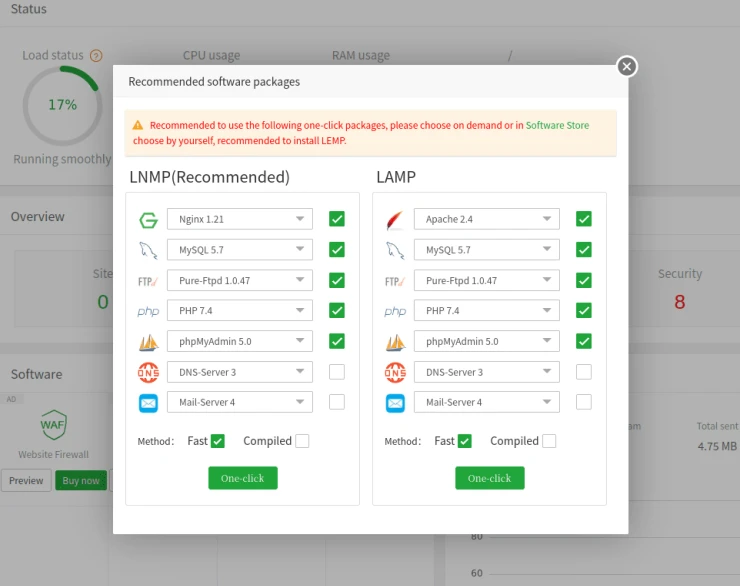How to Set Up Your Own Web Hosting with aaPanel: A Step-by-Step Guide
 Vic okeke
Vic okeke
In today’s digital world, having control over your web hosting environment is crucial for developers and startups. Whether you’re looking to host your personal project or manage multiple websites, setting up your own web hosting can give you the freedom and control which shared hosting often lack. However, managing everything manually on a bare server can be complex and time consuming, requiring advanced technical knowledge and constant maintenance.
This is where aaPanel comes in—a free, user friendly web hosting control panel which makes managing your own server easy and straightforward, even if you’re not a systems administrator. With aaPanel, you can deploy websites, manage databases, securely set up SSL certificates and much more, all with a friendly user interface.
In this guide, We’ll walk you through setting up your own web hosting using aaPanel, from configuring your VPS to deploying your first website. In the end, you’ll have a fully operational web hosting environment tailored to meet your needs, without involving any third party services.
Prerequisites
A VPS (Virtual Private Server). You can get one from Digital Ocean.
SSH access to the VPS (usually sent to your email by the VPS provider).
Basic knowledge of Linux.
Getting started with aaPanel
aaPanel supports a range of Linux distributions and can be installed in just a few steps. In this section, we will guide you through installing aaPanel on a fresh VPS instance. For this example, we’ll be using a Ubuntu 22.04 server, but the steps for other distributions like CentOS or Debian are very similar.
Prepare your VPS.
Before installing aaPanel, you’ll need to set up your VPS and ensure it’s ready for the installation:
First off, login to your VPS using an SSH client like Putty or you can use the default command line of your system by pressing Win+R on windows and typing cmd. On MacOs, hold down the Command + Spacebar.
Secondly, Enter your VPS credentials which was sent to you by your VPS provider. if you’re using a terminal, enter the following command:
ssh root@your-server-ip
Remember to replace “root“ with your VPS username and “your-server-ip“ with the IP Address given to you.
Enter your VPS password. Most times, it doesn’t show that you’re typing while putting in the password, but just keep going as it’s actually being recorded.
Once you’re logged in to the VPS, ensure everything is up to date. This can be done with the following commands:
sudo apt update -y && apt upgrade -y
Install aaPanel
Now that your VPS is up to date, you can install aaPanel using the following command below:
wget -O install.sh http://www.aapanel.com/script/install-ubuntu_6.0_en.sh && sudo bash install.sh
This would take a couple of minutes to complete. After installation, the system would display the following information:
Your aaPanel login URL
Your aaPanel username
Your aaPanel password
This is how it would be displayed:
aaPanel install completed!
==================================================================
aaPanel: http://<your-server-ip>:8888/<panel-path>
username: <your-username>
password: <your-password>
==================================================================
Ensure to copy out these information and store because we would need them later on in this tutorial.
Access aaPanel
Now that you have your login credentials and URL, open a new tab on your web browser. On the address bar, enter the login URL given to you in the previous step.
http://<your-server-ip>:8888/<panel-path>
You will now be presented with a login page, enter the login username and password which was given after the aaPanel installation, and you would be navigated to your aapanel control panel.
Configure your software stack
Once you’re logged in for the first time, aaPanel guide would prompt you into selecting a stack for your installation, you can choose the LAMP stack which includes Apache, MySQL and PHP or the LNMP stack which includes Nginx configuration. Select one according to your choice of preference and wait for installation to complete.

Security recommendations
aaPanel will suggest enabling security measures like IP access restrictions and firewalls. Follow these suggestions to secure your panel and server.
Congratulations. You can now start managing your server resources, domains, SSL certificates, and more through the aaPanel dashboard.
Subscribe to my newsletter
Read articles from Vic okeke directly inside your inbox. Subscribe to the newsletter, and don't miss out.
Written by

Vic okeke
Vic okeke
Hey, I'm Vic Okeke, a software developer and niche blogger with a deep passion for programming and writing. I've been working in the software development industry for several years and have honed my skills in various programming languages and technologies. Through my extensive experience, I've become an expert in developing complex software applications and systems, working with teams to deliver high-quality solutions that meet business needs. In addition to my software development work, I have a keen interest in niche blogging. I started my blog as a way to document my experiences in the industry and share my knowledge with others who are just starting their journey in software development. Through my blog, I share insights and tips on programming, software engineering, and other topics that are relevant to the industry. As a passionate and dedicated software developer, I'm always looking for ways to improve my skills and stay up-to-date with the latest developments in the field. I'm committed to continuous learning and am constantly exploring new tools and techniques to improve my work. In this blog, I'll be sharing my expertise in software development, as well as my experiences and insights on niche blogging. Whether you're an experienced developer looking to expand your knowledge or a beginner just starting out, my blog is a valuable resource that you won't want to miss.